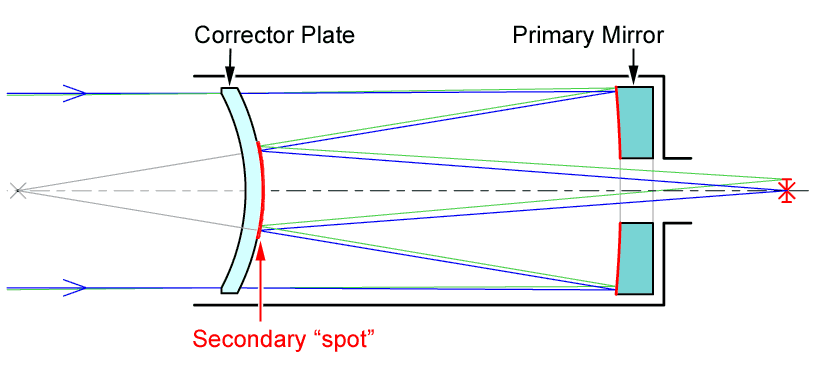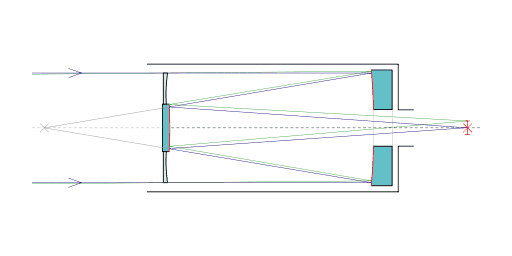Aside from the sky’s darkness, one thing to keep in mind is the best equipment to look for celestial beings. There are several brands with a good reputation but which is better? This comparison between Maksutov-Cassegrains and Schmidt-Cassegrain might come in handy to find the best fit. Now, the battle begins!
What to look for in a telescope?
Before starting to compare brands, one must be sure about what are the qualities that a great telescope needs to have.
For starters, the image quality through the eyepiece is key.
The best telescope to stargaze with is the one that lets the observer have a clear sight of what they’re looking at. What does this mean? Simple: The image should be sharp from edge to edge.
Another thing to take into consideration is how it moves and feels. According to Elizabeth Howell from Space.com, a telescope needs to have a precise focuser and smooth movement from both access.
Also, its mount has to be sturdy and stable, with a tube that stops shaking once it’s touched. This is important because it would be inconvenient and dangerous to have a telescope fall while looking for stars in the sky.
Comfort should also be a priority while buying a telescope. The eyepiece should be at a comfortable height that facilities its use while seated. After all, who wants to stand for a long period? Nobody, for sure. Finally, the finderscope needs to have high adjustability and allow the observer to look through with ease.
This might seem obvious, but it can be easily forgotten by anyone while they’re trying to determine which works the best for their needs and their wallet.
What does this have to do with the whole Maksutov-Cassegrain vs Schmidt-Cassegrain debacle? Well, they’re the most popular brands of compound telescopes, which use lenses and mirrors to gather light. One great thing about them is that their tubes are lighter and more compact, thus, making them more portable.
What’s the difference?
Before outlining the differences between both telescopes, it is important to learn about what makes them unique.
Cassegrains have a mirror on the front and a lens on the front, thus, correcting the characteristic image coma that most Newtonians and Dobsonians tend to have. They’re commonly used by amateur astronomers. Another great thing about them is how multipurpose they are and how perfect they can be for astrophotography, planetary, and deep-sky viewing, but more on that later.
Cassegrains also fold their focal length to a shorter tube, making them more compact than a Newtonian or a Dobsonian.
These telescopes offer great optical quality and most SCTs come with motor-driven tracking and computerized functionalities that make them convenient. They only require optical alignment (collimation) occasionally and tend to hold their focus for years.
While buying a product, it is crucial to know its disadvantages as well. No matter how good a telescope is, some things can affect their quality and the overall experience with them.
One of the setbacks of a Cassegrain is the fact that the correcting lens and motorized tracking add more cost, compared to other models. Also, their scopes are more expensive than a Newtonian of the same aperture.
However, people who have money to spare can customize them with ease.
Cassegrains have a longer focal length, which gives them a narrower field of view. Their mounts are compact but they can be heavy, so extra precautions will need to be taken when it comes to weight.
On the other hand, their closed tubes make them slower to cool down to ambient temperature. Now that their main features have been described, let’s dive into how they work and what they do best, to determine which is better than which.
How Maksutov-Cassegrains Telescopes Work

This telescope could be considered Schmidt-Cassegrain’s sibling since it’s pretty much an alternative design.
Despite being equally popular, some differences can be easily spotted by veterans. The Mak-Casses, an affectionate nickname by enthusiasts, are multipurpose, being commonly used for photography, terrestrial observing, and stargazing.
These telescopes have a catadioptric design, which means that the Mak-Casses use lenses and mirrors, as it was mentioned above.
They’re reflecting telescopes with a corrector lens that allows them to eliminate imperfections that a mirror would cause.
The light passes through and it’s reflected from a concave mirror at the back of the scope, focusing it to the front of the telescope.
Then, a smaller, convex secondary mirror reflects it again, only to travel back through a hole in the primary mirror to the rear of the scope, which is where the eyepiece is located.
Mak-Casses have focal lengths that are 5-7 times longer than their tube length. This is surprising, considering that it is assumed that their focal length is twice as long as it’s tube because of how the light travels. Their powerful range is due to the convex curvature of the secondary mirror.
This addition magnifies the telescope’s focal length and enhances its scope.
The primary mirror of a Maksutov-Cassegrain is a whole other story. Its focal length is about three times its diameter.
Placing a convex secondary mirror between the primary mirror and the focal point reflects the light to it, although at a less steep angle.
One peculiar thing about Mak-Casses is that most of them have secondary mirrors that magnify the focal length 5 times its regular scope.
How Schmidt-Cassegrain Telescopes Work

Similar to Maksutov-Cassegrains, Schmidt-Cassegrains use a combination of mirrors and lenses, folding the optics to form an image.
This is known as catadioptric optics, in which the light enters an aspheric correcting lens, striking the spherical primary mirror and reflecting it up the tube.
Then, a small, convex spherical secondary mirror reflects the light out of the opening in the rear of the instrument, forming the image at the eyepiece.
These telescopes have the most modern design that combines the advantages of both lenses. Schmidt-Cassegrains have a focal ratio of 10, making them perfect for deep sky observing and astrophotography.
One amazing thing about these telescopes is the fact that their close tube design prevents air currents from degrading the image.
Difference between Maksutov-Cassegrains and Schmidt-Cassegrain
Their main difference is the corrector lens at the front of the telescope. Both of them use spherical mirrors that induce spherical aberrations.
This is where the corrector lens comes in, getting rid of this disturbance so the observer can have the best image quality while stargazing.
Another advantage of the corrector lens is the fact that it makes these telescopes relatively inexpensive.
SCTs, another name for the Schmidt-Cassegrain telescopes, use a flat corrector with a slight aspheric curve. Mak-Casses, on the other hand, use a meniscus corrector, which is a highly curved spherical lens. However, their corrector is thicker, reducing the speed of its thermal equalization to the outside temperature.
So What Does This Effect?
Unlike SCTs, Mak-Casses have longer focal ratios, which makes them less suitable for deep-sky photography. The longer the focal ratio, the more exposure time is required.
This makes faint objects harder to spot. Also, most Mak-Casses tend to be slow despite having focal ratios of 10.
Which is better Maksutov-Cassegrains or Schmidt-Cassegrain?
It depends on what the observer is looking for. Both telescopes have their advantages and disadvantages, so it is important to choose wisely.
Schmidt-Cassegrains have excellent optics with razor-sharp images over a wide field, which makes them perfect for lunar, planetary and binary star observation, as well as photography and terrestrial viewing.
Despite being extremely compact, low-maintenance and easy to use, they’re more expensive than Newtonians of equal aperture. Also, they’re not so lucky in the looks department due to their short tube. Most people don’t expect telescopes to look that way, making them less appealing. Another thing is that their secondary mirror prevents light from passing through.
Mak-Casses tend to be more suitable for visual use or planetary imaging. Larger versions of their design are pretty rare, their smaller sizes are the most common.
Since Maksutov-Cassegrains are not fit for deep-sky imaging, they tend to be outshined by SCTs in popularity. Although the former can outperform the latter, it will require a more expensive Mak-Casse.
Although Mak-Casses and SCTs are in the same price range, and SCT tends to be more popular due to its versatility. For people who are looking for a compact telescope with the visual performance of a large-aperture refractor, Maksutov-Cassegrains are the best option.
Conclusion
It is important to look for a telescope with a quality eyepiece, an adjustable mount, and a precise focuser. Cassegrains tend to be a popular option due to how portable and multi-purpose they are.
Maksutov-Cassegrain and Schmidt-Cassegrain are the most popular brands of composed telescopes, which are great for astrophotography, planetary and deep-sky viewing.
Both of them are foldable, have excellent optical quality and have features that can be added, such as motor-driven functionalities.
However, they have a narrower scope, something the users will need to ponder before buying. Determining which of them is the best depends on their needs.



